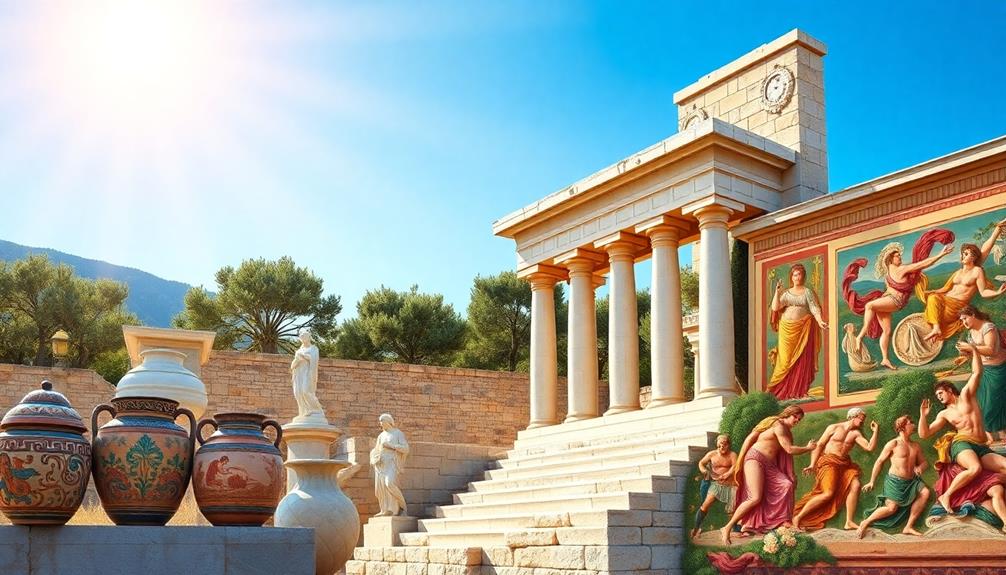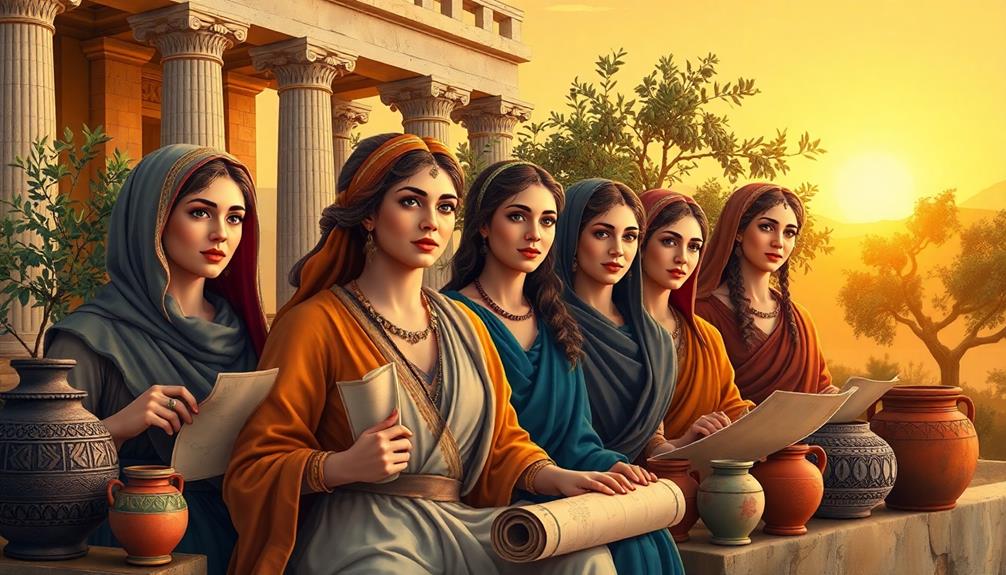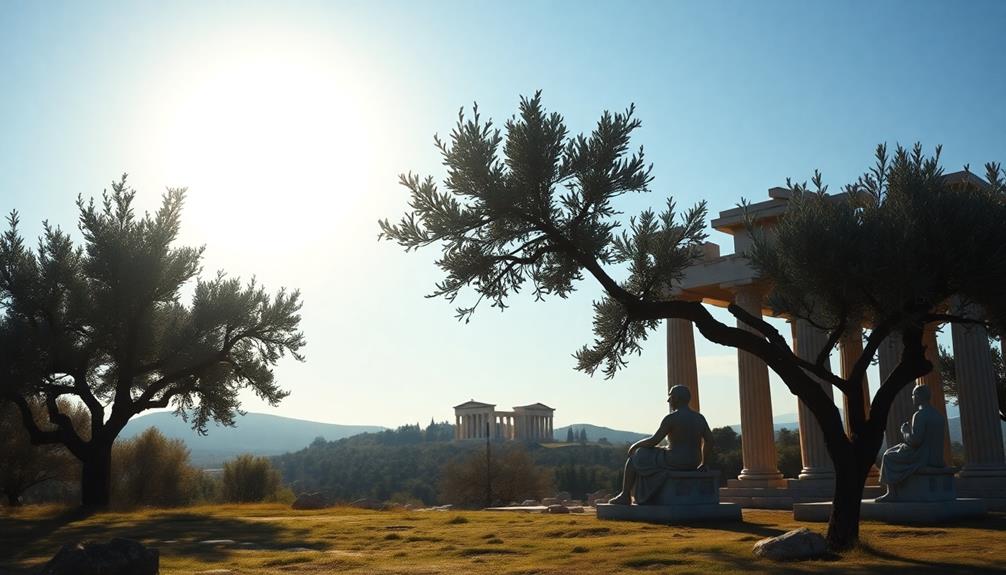Greek art is truly astounding and packed with surprises. Did you know that sculptures evolved from rigid poses into lifelike representations with dynamic movement? Artists used materials like marble and bronze, which allowed for intricate detailing and realism. Ancient statues were originally painted in vibrant colors, making them more lifelike than the common white marble you see today. Naked forms celebrated beauty and athleticism, while mythological themes reflected deep cultural values. The philosophical ideas of ideal beauty influenced these masterpieces. There's so much more to explore about its remarkable history and impact on art, so keep going for even more intriguing insights!
Key Takeaways
- Greek sculptures were originally vibrantly colored, challenging the misconception that they were purely white marble creations.
- The use of contrapposto transformed static poses into dynamic, lifelike representations of movement in sculpture.
- The chryselephantine technique combined gold and ivory, showcasing the luxurious craftsmanship of ancient Greek artists.
- Nude male figures celebrated athleticism and beauty, while female nudity symbolized fertility and divine grace, reflecting cultural values.
- Innovations in materials, like bronze, allowed for intricate detailing and greater flexibility in artistic expression, influencing future generations.
Origins of Greek Sculpture
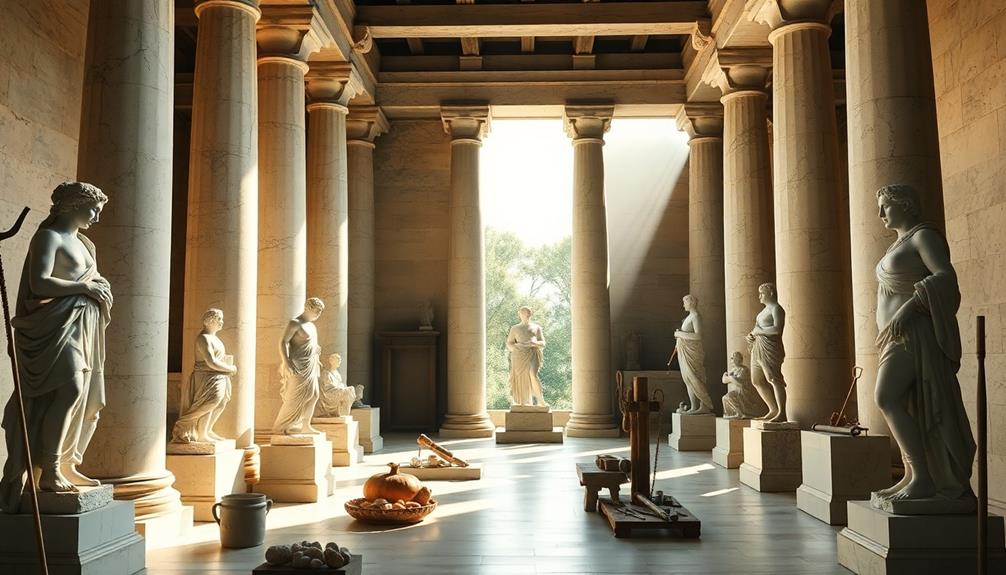
Greek sculpture has fascinating origins that trace back to the techniques learned from the Egyptians. Initially, Greek sculptors produced works that imitated the rigid poses characteristic of Egyptian statues. However, as time passed, they pushed the boundaries of their craft, gradually evolving towards a classical aesthetic.
You'll notice that this new style emphasized freedom of movement and idealized proportions, marking a significant departure from earlier traditions.
The transformation from the Archaic to the Classical period in Greek sculpture is particularly striking. Early statues often appeared stiff and frontal, but later works showcased more naturalistic poses and expressions. This shift reflects a deeper understanding of human anatomy and form, which the Greek sculptors mastered over centuries.
Key innovations in Greek sculpture, such as the use of contrapposto, allowed figures to appear more dynamic and lifelike. This technique, where the weight is shifted onto one leg, creates a sense of movement and balance that was revolutionary at the time.
Ultimately, these advancements highlight the Greeks' relentless pursuit of arete, or excellence, in their artistic endeavors, forever changing the landscape of sculpture.
Materials Behind the Masterpieces
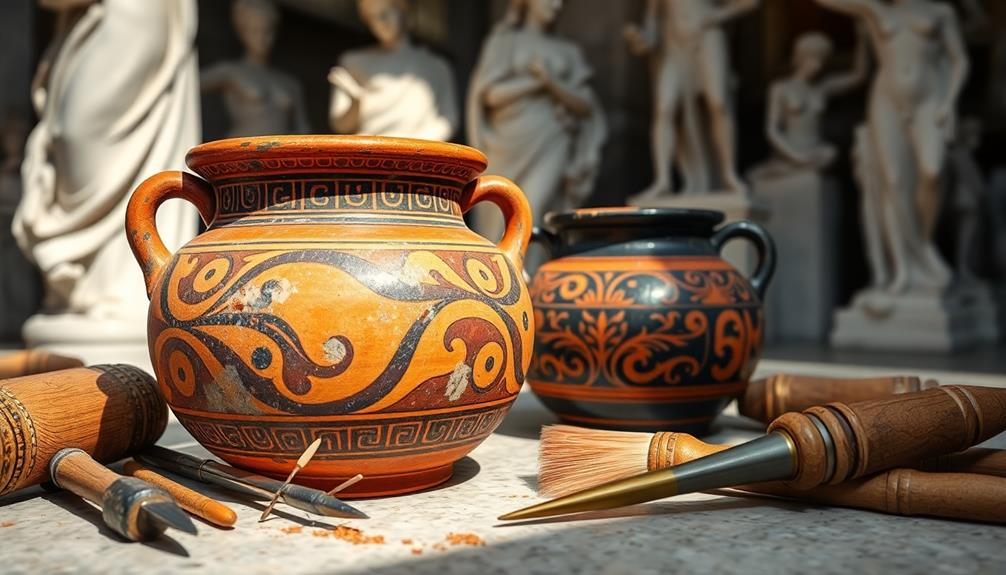
When you explore Greek art, you'll notice the variety of materials sculptors used, like marble and bronze.
The chryselephantine technique, which combined gold and ivory, showcases the luxurious craftsmanship of the time.
Plus, notable discoveries like the Artemision Bronze highlight the remarkable skill and innovation of ancient Greek artists.
Common Sculptural Materials
Ancient sculptors primarily relied on two materials: marble and bronze. Marble was favored for its durability and aesthetic appeal, leading to many surviving Greek statues showcasing its elegant forms. This high-quality stone allowed sculptors to create intricate details, giving life to the figures they crafted.
Bronze, on the other hand, offered flexibility and strength, enabling artists to produce dynamic poses and elaborate designs. The Artemision Bronze, discovered in 1926, exemplifies this material's significance, likely representing either Zeus or Poseidon.
While marble and bronze were the primary choices, sculptors also experimented with limestone, terracotta, and wood for different effects. For more luxurious works, the chryselephantine technique—a combination of gold and ivory—was used, although these pieces are rare.
Additionally, Greek statues were often painted with vibrant pigments, which provided lifelike features and intricate clothing designs. Unfortunately, much of this color has faded over time, leaving behind the striking yet monochromatic forms we see today.
Techniques of Chryselephantine Creation
To create chryselephantine sculptures, artisans combined gold and ivory in a meticulous process that showcased their remarkable skill. They began by constructing a sturdy wooden core, which served as the foundation for these grand works of art. This core was then covered with intricately carved ivory, allowing for detailed representations of deities and important figures.
To enhance the visual impact, artisans adorned the sculptures with gold leaf or thin sheets of gold, highlighting the divine qualities attributed to the figures.
One of the most notable examples of chryselephantine sculptures is the statue of Athena Parthenos, created by Phidias for the Parthenon. Standing approximately 40 feet tall, this masterpiece exemplified the luxurious beauty and artistic expertise of ancient Greece. The use of chryselephantine not only reflected the wealth of the period but also emphasized the significance of the figures represented.
Despite their grandeur, very few original chryselephantine sculptures have survived due to the repurposing or destruction of gold and ivory components over time.
This scarcity adds to the mystique and allure of these extraordinary creations, leaving us in awe of their historical significance.
Notable Bronze Discoveries
Greek bronze sculptures offer a fascinating glimpse into the artistry and innovation of the period, showcasing the skill of sculptors who mastered this durable material. Among the most notable bronze discoveries is the Artemision Bronze, found in 1926 at an ancient shipwreck site. This masterpiece, believed to represent either Zeus or Poseidon, exemplifies the intricate details Greek sculptors achieved with bronze, a medium chosen for its strength and capacity to capture life-like forms.
While many bronze works have been lost to time, often melted down for scrap, the surviving pieces are invaluable for understanding ancient art. Notable lost works, such as the original bronze statues of the Discobolus and Doryphoros, reveal how Greek artists innovatively used bronze to depict dynamic poses and idealized human forms.
The enduring allure of these notable bronze discoveries highlights the importance of this material in Greek art history. In a landscape dominated by marble, these rare bronze sculptures remind us of the technical prowess and creative vision of ancient Greek artisans. They invite you to explore the remarkable legacy that continues to influence art today.
Vibrant Colors of Ancient Statues

When you think of classical sculptures, it's easy to picture them as pristine white marble figures, but that's a misconception. In reality, ancient Greek statues were originally adorned with vibrant colors and intricate decorations. Fragments of ancient pigments found on these sculptures reveal a stunning array of bright hues, which greatly contributed to their lifelike appearance.
Imagine walking through an ancient Greek temple, surrounded by figures that shimmered in red, blue, and gold. The use of metals for hair and eyelashes added even more realism, creating a dynamic visual experience.
Moreover, the eyes of these statues were often crafted from painted ivory or glass stones, emphasizing the detailed and colorful presentation typical of Greek art. This attention to detail wasn't just for aesthetics; the decorative techniques and color choices conveyed deeper cultural significance related to identity and status.
Next time you admire a classical sculpture, remember that it once burst with color, transforming how you appreciate Greek art. By understanding the original vibrancy, you can truly grasp the genius of these ancient creators.
Significance of Nudity in Art

When you explore the significance of nudity in Greek art, you'll notice how male nudity is celebrated as a symbol of beauty and athleticism, standing out from other ancient cultures.
In contrast, female nudity often connects to fertility and religious practices, creating a stark difference in representation.
You'll also see how artistic techniques evolved, using drapery to balance themes of voyeurism and divine power in depictions of gods and goddesses.
Male Nudity Celebration
In ancient art, the celebration of male nudity stands out as a striking embodiment of beauty and athleticism. Unlike other civilizations, where nudity was often seen as shameful, Greek culture embraced it, particularly in contexts like athletics and symposiums. This acceptance reflects a rich cultural tapestry where homoeroticism flourished, allowing artists to depict the male form in its most idealized state.
To illustrate this, consider the following table showcasing different aspects of male nudity celebration in Greek art:
| Aspect | Description | Example |
|---|---|---|
| Idealized Beauty | Male nudity represented perfection and strength | Statues of athletes |
| Athletic Context | Public nudity was common in sports and competitions | Panhellenic games |
| Cultural Significance | Nudity showcased societal norms and values | Vase paintings |
| Artistic Techniques | Use of form and proportion to highlight masculinity | Classical sculptures |
This male nudity celebration highlights a significant disparity in representation, contrasting sharply with female nudity, which primarily focused on fertility rather than athleticism. Greek art not only captured the male form but also expressed broader cultural values surrounding beauty and identity.
Female Nudity Context
Greek art presents a stark contrast in how nudity is portrayed between genders, with female nudity often embodying fertility and divine beauty rather than athleticism. While male nudity was celebrated for its idealized representations, female nudity appears less frequently, reflecting societal norms of the time. Women were typically depicted in clothing, reserved for contexts tied to fertility or religious rituals.
Key aspects of female nudity in Greek art include:
- Fertility Symbolism: Female figures often represent abundance and motherhood, emphasizing their role in society.
- Voyeurism in Art: Athenian vase paintings showcase scenes of bathing or dressing, where male spectators are portrayed as voyeurs, highlighting an interesting tension between observation and divinity.
- Divine Representation: Sculptures of goddesses like Aphrodite blend eroticism with divine power, using drapery techniques to enhance the allure of female forms.
This limited representation of female nudity contrasts sharply with the more liberated depictions of male figures, underscoring the cultural attitudes toward gender and sexuality in ancient Greek society.
Understanding this context enriches your appreciation of the nuances in Greek art.
Artistic Techniques Evolving
Evolving artistic techniques in ancient Greece reveal how nudity served as a powerful medium for expressing cultural ideals. Unlike other ancient cultures, where male nudity often carried shame, Greeks celebrated it as a symbol of beauty and athleticism.
You'll notice that male figures in athletic poses embody the peak of physical form, while female nudity is less common and tied primarily to fertility and religious rituals.
As you explore Greek art, you'll see how nudity is depicted in sculptures and vase paintings, often drawing attention to themes of voyeurism and eroticism. Women are frequently shown in scenes of bathing or dressing, subtly highlighting the social dynamics of Athenian culture.
Artistic techniques like drapery enhance the eroticism of female forms, creating a fascinating tension between the viewer's gaze and the divine power of the subjects.
These artistic expressions aren't just about aesthetics; they reflect broader cultural values surrounding honor, beauty, and the human form.
You'll find that the legacy of these artistic techniques has profoundly influenced Western civilization's understanding of art and the human body.
Philosophical Underpinnings of Greek Art
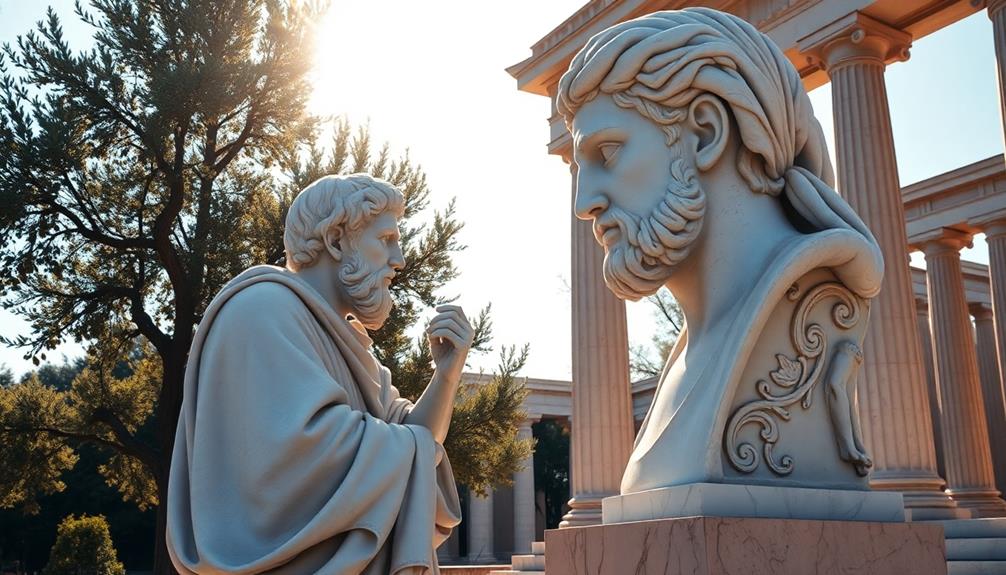
Art in ancient Greece wasn't just about aesthetics; it was a profound expression of philosophical beliefs. The philosophical underpinnings of Greek art shaped how artists approached their work, intertwining beauty with deeper truths about existence. Artists saw themselves as philosophers, believing that their creations mirrored divine beauty and the cosmos.
Consider these key aspects that influenced Greek art:
- Arete: This concept of excellence and virtue led to idealized forms and harmonious proportions, especially in sculpture.
- Plato's Ideal Forms: Philosophers like Plato argued that art should depict ideal forms, guiding artists to aim for perfection.
- Integration of Art and Science: Works like Polykleitos's Canon highlighted mathematical ratios to achieve ideal beauty, merging artistic and scientific principles.
These philosophical beliefs fostered individuality and personal responsibility, reflected in the way mythological figures balanced divine qualities with human traits.
Artistic Techniques That Transformed Sculpture
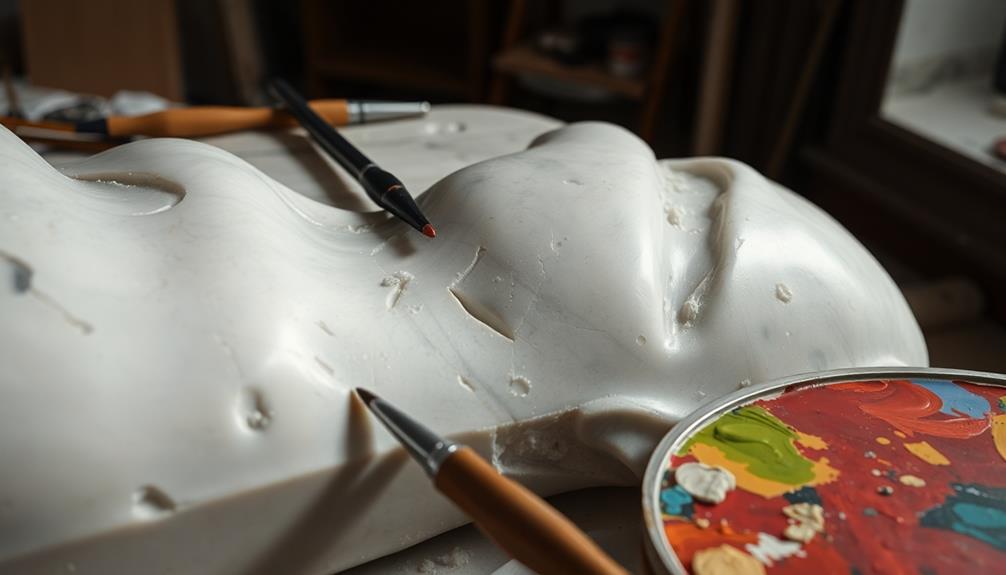
As you explore the evolution of sculpture techniques in Greek art, you'll notice how innovations in material usage played a critical role in enhancing both form and expression.
The shift to more naturalistic representations reflects a deeper understanding of human anatomy and movement.
Evolution of Sculpture Techniques
The evolution of sculpture techniques in ancient Greece represents a remarkable journey toward realism and expression. Starting with the Cycladic figurines, the ancient Greeks laid the groundwork for marble carving, emphasizing human beauty.
As you explore this transformation, you'll notice key shifts that defined Greek sculpture:
- Archaic to Classical Shift: The rigid poses of kouroi evolved into more naturalistic forms, showcasing anatomical accuracy.
- Polykleitos' Influence: His Doryphoros introduced a mathematical canon for ideal proportions, setting a standard for beauty in sculpture.
- Dynamic Motion: Myron's Diskobolos captured athletic action, showcasing both engaged and relaxed elements, paving the way for future sculptors.
These advancements highlight the ancient Greeks' relentless pursuit of perfection in their art. Each technique not only enhanced realism but also deepened the emotional connection viewers felt with the sculptures.
As you explore the intricacies of these techniques, you'll appreciate how they transformed the representation of the human body and influenced generations of artists. The evolution of sculpture techniques truly reflects the ingenuity and creativity of Greek culture, leaving a lasting legacy in the world of art.
Innovations in Material Usage
Building on the advancements in sculpture techniques, material usage in ancient Greek art played a pivotal role in achieving realism and expressing human emotion. Sculptors primarily turned to materials like limestone, marble, and bronze, with marble standing out for its durability and beauty. This choice allowed for the creation of stunning, long-lasting statues that captured the essence of the human form.
Innovations in material usage also included the chryselephantine technique, which combined gold and ivory to produce opulent pieces like the monumental statue of Athena in the Parthenon. The use of bronze further revolutionized sculpture, enabling artists to depict dynamic poses and intricate details, as seen in the Artemision Bronze.
Additionally, the shift from rigid forms to more naturalistic representations was marked by the development of flowing drapery techniques. These innovations enhanced the lifelike quality of figures, making them appear more animated and relatable.
Incorporating painted details, such as metal hair and vibrant pigments, transformed Greek statues from monochromatic to vivid representations, enchanting viewers and showcasing the mastery of ancient artisans. Through these material innovations, Greek art truly flourished, leaving a lasting impact on the world of sculpture.
Impact of Naturalism
Naturalism in Greek sculpture transformed the art form, making it more relatable and expressive. This shift from rigid Archaic poses to lifelike representations in Classical art emphasized the human form's anatomical accuracy and dynamic movement. Artists embraced techniques that allowed them to capture the essence of humanity, leading to a profound evolution in sculpture.
- Sculptors like Polykleitos introduced the "Canon," setting guidelines for idealized beauty and harmony in the human figure.
- The use of foreshortening and in-depth studies of anatomy enabled realistic representations, as seen in Myron's Diskobolos, which embodies athletic action.
- Late kouroi sculptures reflect softened forms, marking a clear change towards naturalism and away from earlier, rigid styles.
The influence of philosophers and scientists during the Greek Golden Age further enriched this artistic movement, fostering a holistic understanding of beauty.
This allowed art to mirror the balance and harmony found in nature, making Greek sculpture not only a representation of the human form but also an exploration of the human experience.
As you explore these transformations, you'll appreciate how naturalism forever changed the landscape of art.
Influence on Western Civilization
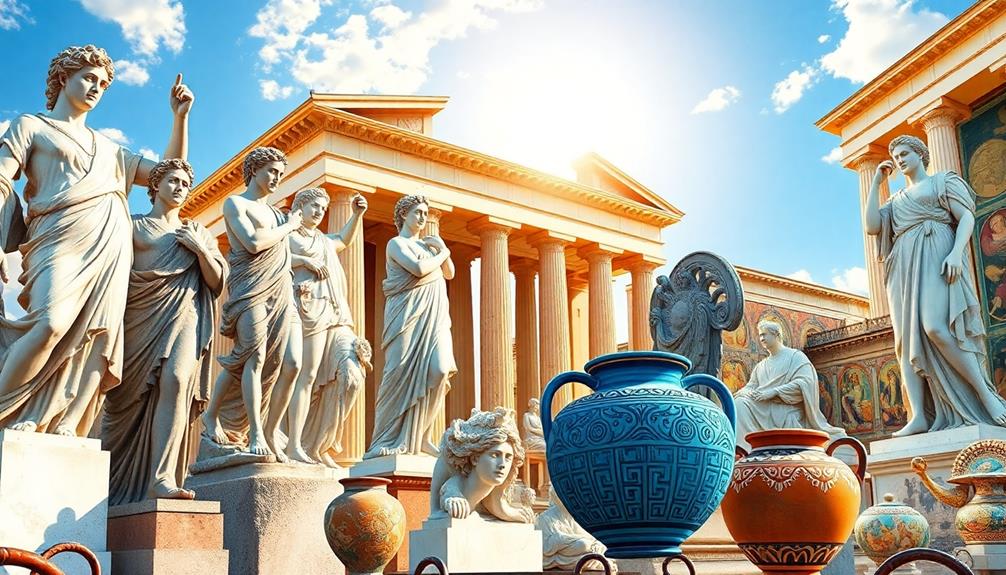
How has Greek art shaped the foundations of Western civilization? Its influence is undeniable. The Greek ideals of beauty and aesthetics directly inspired Renaissance artists like Michelangelo and Raphael, who meticulously emulated Greek forms and proportions. This revival marked a high point in art history, showcasing how deeply embedded Greek artistry is within Western culture.
Moreover, the integration of art and philosophy in ancient Greece laid the groundwork for Enlightenment thinkers, who viewed Greek culture as the pinnacle of rational thought and artistic excellence. The Romans played a significant role in this narrative, heavily adapting and replicating Greek art. Wealthy Romans commissioned copies of Greek sculptures, allowing these principles to spread throughout the Roman Empire, further embedding them into Western civilization.
Greek artistic techniques, such as contrapposto and idealized proportions, became foundational in Western sculpture. These techniques continue to be central in modern art education.
Additionally, the emphasis on humanism and individualism in Greek art has profoundly shaped contemporary views on identity and self-expression, ensuring that the influence of Greek and Roman art resonates powerfully throughout Western civilization today.
Mythology's Role in Artistic Expression
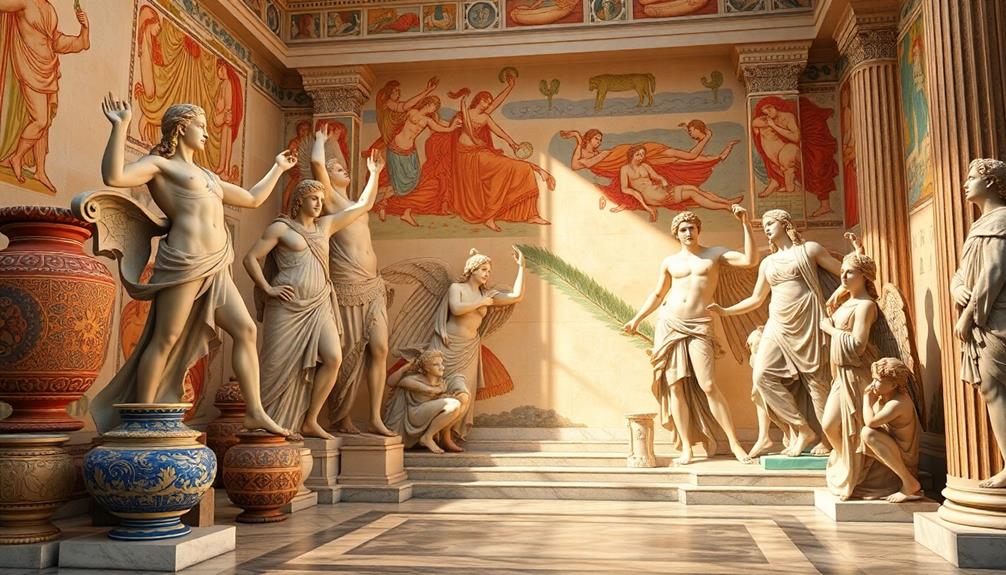
In the vibrant world of Greek art, mythology served as a powerful lens through which artists expressed cultural values and ideals. You'll notice how mythological themes permeate every aspect of classical Greek artistry, illustrating the interconnectedness of human experience and divine inspiration. The goddess of love, Aphrodite, along with other mythic figures, became central to various artistic representations, showcasing ideals of beauty and virtue.
Consider these key aspects of mythology's role in artistic expression:
- Thematic Depth: Artists often depicted mythological narratives, like Athena with Marsyas, emphasizing storytelling's importance in Greek culture.
- Realism and Divinity: Works like the Kritios Boy merged divine qualities with realistic human traits, reflecting philosophical dialogues about aesthetics.
- Cultural Heritage: Engraved sealstones often referenced mythological tales, such as discus-throwing, blending athleticism with mythic heritage.
Through these elements, Greek art not only celebrated mythology but also conveyed deeper meanings about society, identity, and the human condition, enriching our understanding of ancient Greece and its enduring legacy.
Evolution From Archaic to Hellenistic
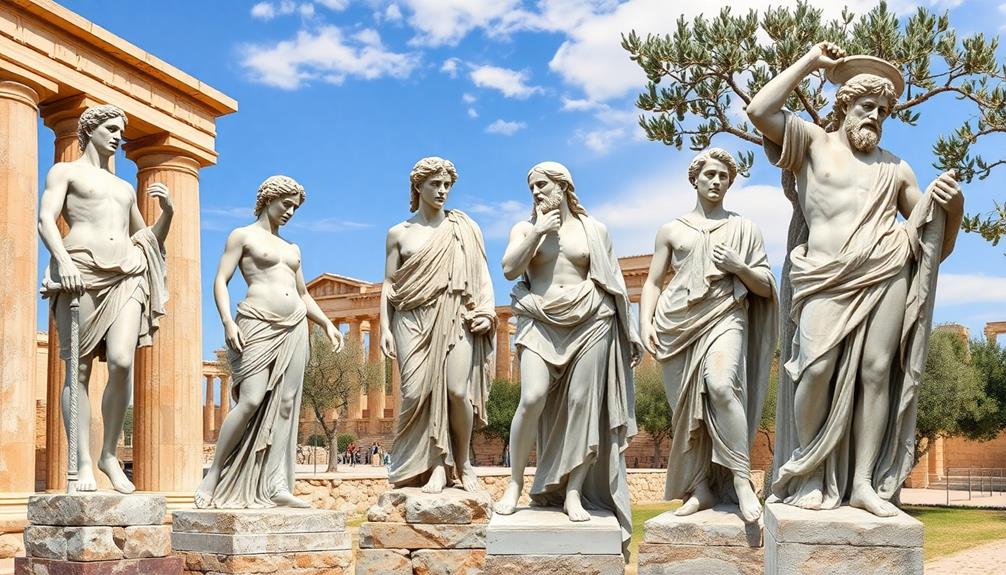
The evolution of Greek art from the Archaic to Hellenistic periods showcases a fascinating transformation in style and expression. In the Archaic period, sculptures like the kouroi displayed rigid, stylized forms, emphasizing a lack of realistic anatomical detail.
As you move into the Classical era, you'll notice a shift towards the human body depicted with greater proportion and movement, exemplified by Polykleitos' Doryphoros. This introduction of contrapposto allowed figures to express dynamism and balance, breaking free from the static poses of earlier works.
Then, during the Hellenistic period, art took a bold turn towards individualism. Sculptures became increasingly realistic and emotionally charged, as seen in masterpieces like the Laocoön Group and the Winged Victory of Samothrace.
This era highlights a broader cultural shift, where artists depicted a wide range of human experiences and emotions. You can feel the emotional depth and narrative complexity in these works, marking a significant departure from the earlier styles.
The evolution from Archaic to Hellenistic art not only reflects changes in technique but also a deeper understanding of the human condition, capturing the essence of life in all its complexities.
Enduring Legacy of Greek Art
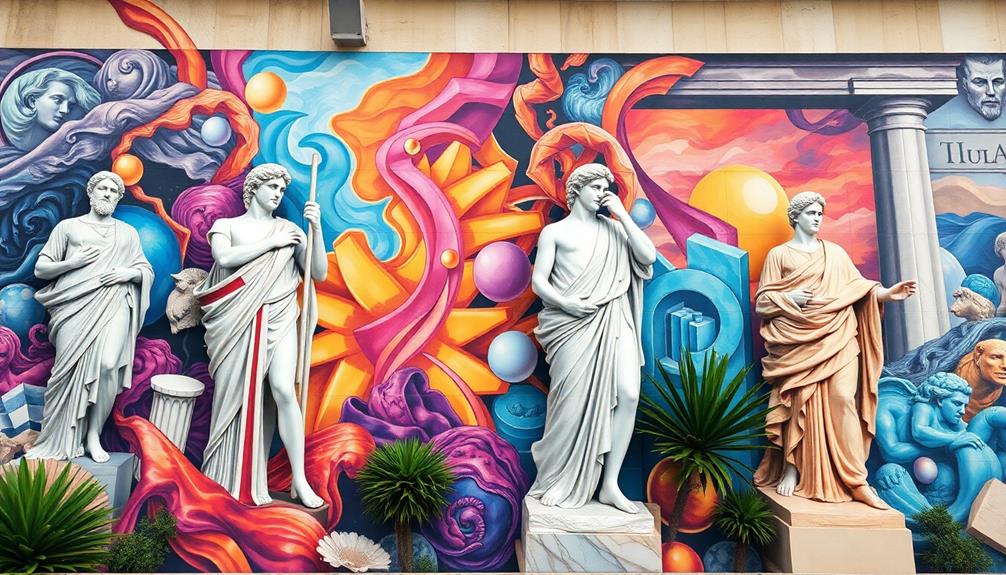
Greek art has left an indelible mark on the world, influencing generations of artists and shaping the very foundations of Western aesthetics. Its enduring legacy is evident in countless ways, reminding you of the moral responsibility artists carry in representing beauty and the human experience.
Consider how Greek art established principles that continue to resonate today:
- Harmony and Balance: These principles serve as benchmarks for Western art, guiding artists in their quest for aesthetic perfection.
- Naturalism and Emotion: The emphasis on the human form during the Renaissance revived classical themes, inspiring artists to explore deeper emotional connections in their work.
- Impact on Identity: Greek artistic ideals inform modern discussions on beauty, influencing how societies perceive and portray the human body.
From ancient sculptures to contemporary media, the echoes of Greek art remain vibrant. You can see its impact not only in visual arts but also in literature, theater, and even film.
As you reflect on these influences, you'll appreciate how the enduring legacy of Greek art continues to shape artistic expression, inviting you to engage with its timeless themes.
Frequently Asked Questions
What Are Some Facts About Greek Art?
Greek art showcases a progression from rigid forms to dynamic naturalism, emphasizing beauty. Statues were originally vibrantly painted, and male nudity celebrated ideals, while female nudity symbolized fertility, reflecting cultural values and contrasting gender representations.
What Are the 4 Main Points of Greek Art?
You might think Greek art's just about pretty sculptures, but it's so much more. The four main points are its evolution, material diversity, celebration of the human body, and narrative integration, shaping Western artistic traditions.
What Can You Say About Greek Art?
Greek art showcases a remarkable evolution, emphasizing naturalism and idealized beauty. You'll appreciate its intricate craftsmanship, vibrant colors, and cultural significance, reflecting values of athleticism and fertility while influencing Western aesthetics for centuries.
What Makes Greek Art Unique?
Did you know that Greek sculptures often adhered to the golden ratio, achieving aesthetic perfection? Greek art's unique blend of idealized beauty, dynamic movement, and vibrant colors revolutionized how you perceive human form and artistic expression.
Conclusion
To sum up, Greek art isn't just about beautiful sculptures or vibrant colors; it's a window into the culture's profound values and beliefs. Imagine walking through a museum and coming across a stunning statue of a Greek god, its colors still vivid after centuries. You feel a connection not only to the art but also to the ideals of beauty, philosophy, and mythology that shaped Western civilization. Greek art truly leaves a lasting impression, inspiring creativity even today.
